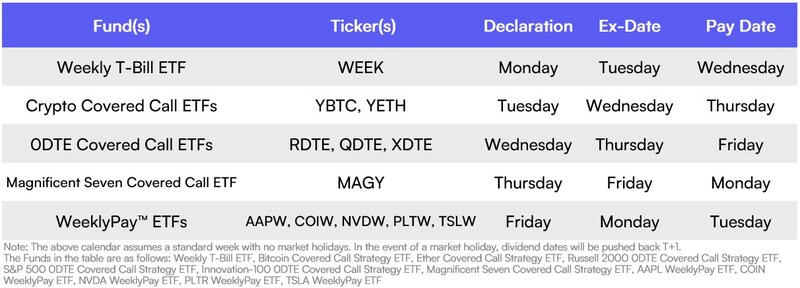
I am a fan of Roundhill Funds and we have 3 of their funds in our income factory portfolio, Rapid Wealth Compounder (more details in the Inner Circle). It is nice to get a substantial income every week like a clockwork. Given that all of these funds are option enhanced and the distribution amount depends on the volatility of the underlying asset during the week, the income varies every week. Covered call ETFs also cap the upside in the capital gain, but as long as the portfolio is focused on income, this is quite acceptable. The income just gets reinvested back in the portfolio and we compound the share count, which in turns increases our distribution over time.
Roundhill has now come up with several new ETFs with staggered pay dates. Additionally, they are moving the pay date for YBTC and YETH ETFs from Fridays to Thursdays, starting in July. This means, you are now able to structure your portfolio in such a way that you have income coming in every single weekday.
Take a look at the table above, and review the tickers column for each pay day. By carefully selecting 5 ETFs, you can ensure daily income on the weekdays.
Is there a Possibility of NAV erosion?
Many of these ETFs yield in the 30%-40% range and possibly even more on an annual basis. The regular admonishment is that high yield means more risk. Higher the yield, there is a greater likelihood of the fund just doing a Return of Capital so the distribution is not sustainable and the NAV will erode over time.
These ETFs are different – they track an index or a stock as an underlying, but the income is generated from the option premiums collected by selling covered calls. Underlying asset does not get liquidated, unless there is a rapid price appreciation, in which case the underlying will get called and there is a risk of not receiving all of the price appreciation. If this happens, the proceeds can be rolled back into the underlying asset – the fund can choose to only distribute the option premium they collected.
I personally have very minimal concerns about NAV erosion. There is a risk of the underlying (index or stock or crypto) to decline which would also drag down the ETF price. However, the income earned from options will buffer the downside.
Why NAV Erosion Risk Is Low (Structurally)
1. Options Premium = External Yield
- These ETFs earn income by selling options (calls, 0DTE, or covered calls).
- That income is additive—it comes from the market, not from selling underlying shares.
- As long as the strategies are executed well, distributions should not require NAV liquidation.
2. Explicit Yield Design
- The ETFs are built to maximize distributable cash flow from option strategies.
- Covered call and 0DTE funds typically manage delta and gamma risk carefully to avoid destructive positions that would require tapping NAV.
3. Daily or Weekly Income Keeps Position Sizing Tight
- Frequent income = frequent resets. This allows for agile position sizing, avoiding buildup of embedded risk over time.
When NAV May Still Decline (Temporarily or Cyclically)
| Cause | Impact on NAV | Frequency | Notes |
|---|---|---|---|
| Equity drawdowns | Moderate | Periodic | NAV falls with market, but less so due to income buffer |
| Volatility crush | Mild | Short-term | Option premiums shrink = less income = minor NAV dips |
| Mispriced tail events | Rare but material | Infrequent | Poorly hedged events could force losses on sold options |
| Slippage & drag | Cumulative minor | Ongoing | Management fees, bid-ask spreads, and rolling costs |
NAV might experience mark-to-market fluctuations, but long-term structural decay is unlikely if the fund maintains discipline.
Bottom line is that while risk of NAV erosion is minimal, there are a few other risks to consider and these risks mainly reside with the fund company and how well their systems work. I have owned Roundhill funds for a while and that gives me confidence to say that they know what they are doing. Of course, if you choose a fund where the underlying is a stock, you need to make sure that the stock in question is an acceptable investment based on your criteria for valuation, risk and expected returns.
Starting a Small Experimental Portfolio to Test the Daily Income System
This is experimental. I want to run this portfolio for a while to see how it works and get comfortable with it.
(If you are inspired to invest in any of these funds for daily income, it is at your own risk. This is not meant to be a recommendation.)
For this experimental portfolio, I picked 1 ETF from each row, thereby giving me a payout on each day of the week. Here are the funds I chose in this portfolio ordered by the payout day:
- Monday: MAGY, underlying is Magnificent 7 stocks
- Tuesday: NVDW, underlying is Nvidia stock
- Wednesday: WEEK, underlying is t-bills
- Thursday: YBTC, underlying is Bitcoin (the payout day is currently Friday but will move to Thursday starting in July)
- Friday: QDTE, underlying is Nasdaq 100 index
This portfolio is in a separate account from the 4 Inner Circle portfolios. The Inner Circle portfolios are not affected. However, it is possible that I may take some learnings from this experimental portfolio into one of our Inner Circle portfolios over time.
Interesting note: Roundhill Funds have launched more WeeklyPay ETFs, including one based on Berkshire Hathaway. The ticker is BRKW. This is a brand new ETF and it does not yet have a distribution history, as of the date of this writing. This could be an interesting candidate to add later on.
One more thing …
I have laid out the risks as I understand them, but some of this is theoretical. The funds are new enough that they have not yet seen a sustained downturn in the market, so they are not yet stress tested. Therefore, I would not advise you to invest serious money in these funds. Probably 5%-10% of your net worth should be the upper limit.

Shailesh Kumar, MBA is the founder of Astute Investor’s Calculus, where he shares high-conviction small-cap value ideas, stock reports, and investing strategies.
His work has been featured in the New York Times and profiled on Wikipedia. He previously ran Value Stock Guide, one of the earliest value investing platforms online.
Subscribe to the Inner Circle to access premium stock reports and strategy insights.
Featured in:







